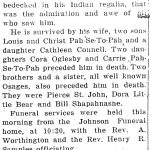February 4, 1938
Osage County News
Microfilm Roll: MN00276
On this day in Osage country, Pah-Se-To-Pah, one of the most “colorful” members of the Osage tribe passed away, at the age of 68, after a three week battle with pneumonia.
Pah-Se-To-Pah was born in Kansas near the Neosho River in the year 1870. His family moved to the Osage reservation when he was only a small child. Growing up on the reservation, Pah-Se-To-Pah became a talented hunter and horse rider so much so that other tribal members dubbed him with the nickname, “the boy hunter.”
At the young age of twelve, after sustaining injuries from a horse racing incident, Pah-Se-To-Pah was left deaf and mute. Although tragic, his accident did not hamper his spirit; his deep passion for horseback riding could not keep him out of the saddle.
Around the age of fifty, Pa-Se-To-Pah is said to have learned a universal Indian sign language, the “Esperanto” language, taught to him by a “well educated Ponca Indian,” J.P. Williams (Universal Sign). The language allowed for Pah-Se-To-Pah to have full contact with people for the first time since his accident.
Pah-Se-To-Pah was also a prominent tribal member. The Osages allowed for Pah-Se-To-Pah to lead their parades, on horseback and in full regalia, no matter the importance of the celebration. He also travelled to Washington on several occasions and met with “The Great White Father” and throughout his life, met many other notable figures around the country (Colorful Indian).
Near the time of his death, Pah-Se-To-Pah requested that his most prized possessions be donated to the Osage Tribal Museum, which opened just a few months after his passing. The donated belongings included his eagle feather headdress, containing “feathers from 74 different eagles,” which was part of his regalia when leading parades, and his turkey bone “love flute” (Pah-Se-To-Pah Collection). In sign, Pah-Se-To-Pah maintained that, “when he rode down the street on his horse and played [his] flute, the ladies always flocked to him” (Pah-Se-To-Pah Collection).
Morgan M. Guzman
“Colorful Indian Figure Passes Here on Tuesday.” Osage County News. February 4, 1938, p. 1. Microfilm roll number MN00312. Sequoyah National Research Center, Little Rock, Arkansas.
Further Reading
“Universal Sign Language Gives Indian Opportunity to Tell Old Stories Here.” The Daily Journal-Capital. May 6, 1928, p.1 & 4. Microfilm roll number MN00276. Sequoyah National Research Center, Little Rock, Arkansas.
“Pah-Se-To-Pah Collection to be preserved at Museum.” The Daily Journal-Capital. April 24, 1938, p. 10. Microfilm roll number MN00298. Sequoyah National Research Center, Little Rock, Arkansas.
Source File(s)
Related Stories
- Osages Only Tribe with Museum
- Universal Sign Language gives Indian Opportunity to Tell Old Stories Here
